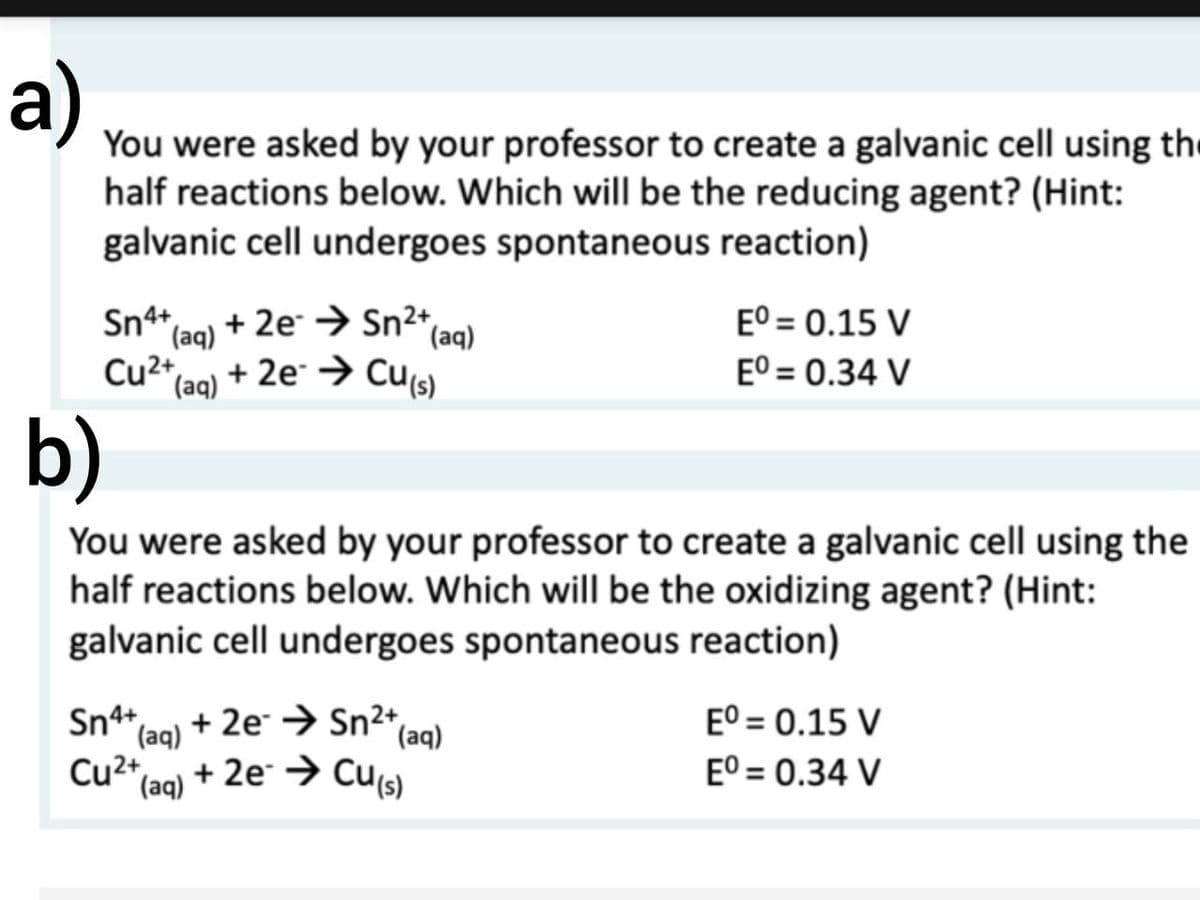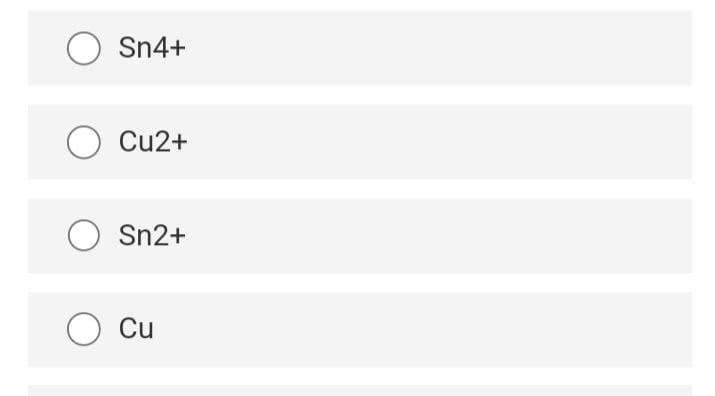a) You were asked by your professor to create a galvanic cell using th half reactions below. Which will be the reducing agent? (Hint: galvanic cell undergoes spontaneous reaction) Sn4+ + 2e → Sn²+ (aq) Cu²+ (aq) + 2e → Cu(s) +2e → Sn²+, (aq) + 2e → Cu(s) b) You were asked by your professor to create a galvanic cell using the half reactions below. Which will be the oxidizing agent? (Hint: galvanic cell undergoes spontaneous reaction) Sn4+ Cu²+ (aq) (aq) Eº = 0.15 V Eº = 0.34 V (aq) Eº = 0.15 V Eº = 0.34 V
a) You were asked by your professor to create a galvanic cell using th half reactions below. Which will be the reducing agent? (Hint: galvanic cell undergoes spontaneous reaction) Sn4+ + 2e → Sn²+ (aq) Cu²+ (aq) + 2e → Cu(s) +2e → Sn²+, (aq) + 2e → Cu(s) b) You were asked by your professor to create a galvanic cell using the half reactions below. Which will be the oxidizing agent? (Hint: galvanic cell undergoes spontaneous reaction) Sn4+ Cu²+ (aq) (aq) Eº = 0.15 V Eº = 0.34 V (aq) Eº = 0.15 V Eº = 0.34 V
Chemistry: An Atoms First Approach
2nd Edition
ISBN:9781305079243
Author:Steven S. Zumdahl, Susan A. Zumdahl
Publisher:Steven S. Zumdahl, Susan A. Zumdahl
Chapter17: Electrochemistry
Section: Chapter Questions
Problem 118AE
Related questions
Question

Transcribed Image Text:a)
You were asked by your professor to create a galvanic cell using the
half reactions below. Which will be the reducing agent? (Hint:
galvanic cell undergoes spontaneous reaction)
Sn4+ + 2e Sn²+,
(aq)
Cu²+ + 2e → Cu(s)
(aq)
(aq)
Eº = 0.15 V
Eº = 0.34 V
b)
You were asked by your professor to create a galvanic cell using the
half reactions below. Which will be the oxidizing agent? (Hint:
galvanic cell undergoes spontaneous reaction)
Sn4+ + 2e → Sn²+ (aq)
(aq)
Cu2+
(aq) + 2e → Cu(s)
Eº = 0.15 V
Eº = 0.34 V

Transcribed Image Text:O Sn4+
O Cu2+
O Sn2+
O Cu
Expert Solution
This question has been solved!
Explore an expertly crafted, step-by-step solution for a thorough understanding of key concepts.
Step by step
Solved in 3 steps with 2 images

Knowledge Booster
Learn more about
Need a deep-dive on the concept behind this application? Look no further. Learn more about this topic, chemistry and related others by exploring similar questions and additional content below.Recommended textbooks for you

Chemistry: An Atoms First Approach
Chemistry
ISBN:
9781305079243
Author:
Steven S. Zumdahl, Susan A. Zumdahl
Publisher:
Cengage Learning


Chemistry
Chemistry
ISBN:
9781305957404
Author:
Steven S. Zumdahl, Susan A. Zumdahl, Donald J. DeCoste
Publisher:
Cengage Learning

Chemistry: An Atoms First Approach
Chemistry
ISBN:
9781305079243
Author:
Steven S. Zumdahl, Susan A. Zumdahl
Publisher:
Cengage Learning


Chemistry
Chemistry
ISBN:
9781305957404
Author:
Steven S. Zumdahl, Susan A. Zumdahl, Donald J. DeCoste
Publisher:
Cengage Learning

Chemistry: The Molecular Science
Chemistry
ISBN:
9781285199047
Author:
John W. Moore, Conrad L. Stanitski
Publisher:
Cengage Learning

Chemistry: Matter and Change
Chemistry
ISBN:
9780078746376
Author:
Dinah Zike, Laurel Dingrando, Nicholas Hainen, Cheryl Wistrom
Publisher:
Glencoe/McGraw-Hill School Pub Co

General Chemistry - Standalone book (MindTap Cour…
Chemistry
ISBN:
9781305580343
Author:
Steven D. Gammon, Ebbing, Darrell Ebbing, Steven D., Darrell; Gammon, Darrell Ebbing; Steven D. Gammon, Darrell D.; Gammon, Ebbing; Steven D. Gammon; Darrell
Publisher:
Cengage Learning